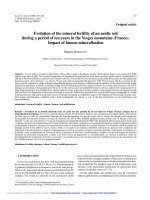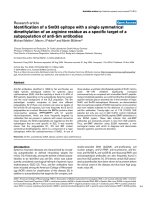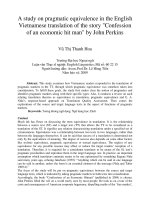Biological properties and the nutrition value of an Isochrysis strain as a live food for geo-duck larvae
Bạn đang xem bản rút gọn của tài liệu. Xem và tải ngay bản đầy đủ của tài liệu tại đây (236.16 KB, 5 trang )
Biological properties and the nutrition value of an Isochrysis strain as a
live food for geo-duck larvae
Le Thi Phuong Hoa
1
, Nguyen Thi Hoai Ha
2
, Pham Thi Bich Dao
2
, Lưu Thị Thùy Giang
2
, Luong
Thanh Hao
3
1
Faculty of Biology, Hanoi National University of Education
2
Institute of Microbiology and Biotechnology, Vietnam National University, Hanoi
3
Faculty of Biology, College of Natural Sciences
Abstract
The addition of Isochrysis galbana H5 ensures a balanced supply of the omega3 and
omega6 fatty acids for the survival and healthy of geoduck larvae. This study has shown that the
critical factor in this diet for geoduck larvae is the content of polyunsaturated fatty acids
(PUFAs), accounted for more than 40 % of total fatty acids, and docosahexaenoic acid (DHA-
5.53 mg per mg fresh weight), which play an important role in the membrane lipids. Medium f/2
was selected as best medium for microalgae culture. Isochrysis galbana H5 is recommended as a
live food for growing larvae and juvenile of fish, bivalves and crustaceans in aquaculture.
Keyword: fatty acid, marine microalgae, geoduck
1. Introduction
Marine microalgae provide the food base which supports the entire animal population of
the open sea. They contain a wide range of fatty acids especially polyunsaturated fatty acids
(PUFAs), which cannot be produced in sufficent quantities for metabolic functioning in most
marine animals [3,5,12]. Many microalgae are believed to improve the nutritional conditions of
the larvae as well as their growth and survival [7,12]. They are widely used in aquatic cultivation
as food for bivalves, crustaceans and fish especially in their larval stage [12]. The
prymnesiophyte Isochrysis is the one of the most commonly used in mariculture, which is rich in
essential fatty acids, omega6-linoleic acid (C18:2n-6) and omega3-linolenic acid (C18:3n-3), and
the highly polyunsaturated omega3 fatty acids, octadecatetraenoic acid (C18:4n-3),
eicosapentaenoic acid (EPA, C20:5n-3) and docosahexaenoic acid (DHA, C22:6n-3) [2,10,12].
Geo-duck is a bivalve species, which inhabits commonly in Quang Ninh and is served as
a specialty with high nutrition [6]. In this study, Isochrysis strains isolated, in a way to find
suitable food for sustainable development and conservation of geo-ducks in their larval stage.
2. Materials and Methods
Isochrysis strains were isolated based on their morphological properties using
micropipettes [9] and jellylike desert dish according to Shirai et al. [8]. They were grown at room
temperature and illuminated under neon light (Philips daylight tubes) on 10: 14 h light: dark
cycles. Media f/2, ASW and ESM [4] were used to select culture medium for the growth and
development. Cells were cultured in 250 ml conical flask and harvested every two days. Cell
density was determined with a Neubauer haemocytometer in three replicates.
Total DNA was extracted and 18S rDNA-coding region were amplified and sequenced
according to An et al. [1]. The 18S rDNA sequences were analyzed using BLAST tool.
Biomass for fatty acid analysis was obtained from 1-4 liter aerated culture suspensions in
plastic containers. Cells were harvested at the log phase to get healthy cells. Fatty acid
composition was determined according to Krienitz et al. [5] by gas chromatography (Finnigan
Trace GC) using an ultra-column BPX70. Fatty acids were identified by comparing retention
times with those of a calibration standard solution.
3. Results and discussion
3.1. Isolation, and classification of Isochrysis strains
Isochrysis strains were isolated based on their morphological properties. One of them is
signified as H5 (Fig. 1).
Figure 1. Microscopic morphology of
Isochrysis H5
Figure 2. Agarose gel electrophoresis of 18S
rDNA
SSU rDNA sequence comparison has proved to be a powerful alternative to morphology
for inferring phylogenetic relationships at all taxonomic levels. The result on analysis and
alignment of 18S rDNA sequences confirms Isochrysis H5 identification as Isochrysis galbana.
Figure 2 shows the18S rDNA amplification products
The phylogenetic tree constructed from neighbour – joining analysis of the sequences of
18SrDNA depiciting relationships of species (Figure 3).
3.2. Selection of culture medium
Optimization of culture conditions for the selected strains is essential for algal mass
culture. Furthermore, growth characteristics have been shown to have a significant impact on the
lipid and fatty acid profiles [1,7]. In this study, medium f/2, ASW and ESM were used. The cells
were collected every two days and counted (Table 1).
H5
Isochrysis galbana
Gephyrocapsa oceanica
Emiliania huxleyi
Coccoid haptophyte
88
100
100
Phaeocystis antarctica
96
Prymnesium nemamethecum
Prymnesium patelliferum
Chrysochromulinda polylepis
100
Chrysochromulina hirta
100
Coccolithus pelagicus
Coccolithus braarudii
Cruciplaccolithus neohelis
100
Pleurochrysis carterae
Pleurochrysis carterae
100
100
87
73
0.005
100
Figure 3. The phylogenetic tree constructed from neighbour – joining analysis of the sequences of
18SrDNA
Table 1. Cell density of Isochrysis galbana grown on different media
Time
(days)
Cell density (x 10
6
/ml)
F/2
ESM
ASW
0
0.7
0.7
0.7
2
0.65
1.05
0.8
4
1.75
1.45
1.1
6
3.75
1.75
1.35
8
4.05
1.8
1.9
10
7.15
2.35
2.35
12
5.65
2.05
2.7
14
5
1.85
2.1
16
4.6
1.55
1.75
18
2.1
0.62
0.76
Isochrysis galbana H5 grew the better in f/2 than in the ESM media and ASW media.
The growth of Isochrysis galbana H5 reached the highest peak after 10 days culture (7.15 x 10
6
cell/ml). It is suggested that f/2 is the most suitable for culturing Isochrysis galbana H5 and can
be applied for biomass production in aquaculture.
3.3. Fatty acid composition
Lipid has its own specificity in each species of living organisms. Fatty acids are mostly
located in the cell membrane, which is much enough to apply to taxonomic characterization
[3,12]. Fatty acid components of Isochrysis galbana H5 were analysed (Table 2).
Table 2. Composition of fatty acids in Isochrysis galbana H5
Fatty acid
Chemical name
Quantities (mg/1mg fresh
weight)
C14:0
Myristic acid
4.16
C16:0
Palmitic Acid
14.69
C16:1
Palmitoleic Acid
2.09
C18:0
Stearic Acid
1.22
C18:1n9
Oleic Acid
5.42
C:18:2n6
Linoleic Acid
2.71
C:18:3n3
Anpha-Linoleic Acid
3.52
C18:4n3
Octadecatetraenoic
18.9
C:20:5n3
Eicosapentaenoic Acid (EPA)
0.24
C22:0
Benhenic acid
15.89
C:22:6n3
Docosahexaenoic Acid (DHA)
5.53
The total fatty acids in Isochrysis galbana H5 are 74.37 g/mg fresh weight. Isochrysis
galbana H5 has a great variety of fatty acids ranging from 14C to 22C, among C16:0, C18:4n-3
and C22:0 are the most abundant fatty acids. The compossition is different from previous report
[10] but major variations in the fatty acid compositions of Isochrysis galbana have been reported
[12]. More than 40 % of total fatty acids (30.9 g/mgfresh weight) in Isochrysis galbana H5 is
polyunsaturated fatty acids, suggesting the high quality of Isochrysis galbana H5 and the
potential to be applied in aquatic food webs such as for feeding geo-ducks. In addition, DHA had
remarkably high content (5.53 g) while EPA was at low abudance, smilar to Isochrysis sp. Clone
T.ISO in previous report [12]. DHA and EPA play an important role in the membrane lipids.
3.4. Application of Isochrysis galbana H5 for feeding geo-duck at Vandon, Quangninh
Isochrysis galbana H5 was cultured in F/2 medium, grown at room temperature and
illuminated under neon light (Philips daylight tubes) 4000 - 5000 Lux as the following scheme
with illustrated pictures
Microalgae volume was used depending on geo-duck larvae density.Geoduck larvae with 2.5x10
5
-16.6x10
5
individuals per m
3
were fed in 120 – 180 liters microalage with cell density 7.7 - 8.2
10
6
cells/ml per day .
Conclusions
The Isochrysis strain were successfully isolated from Vandon, Quangninh and identified
as Isochrysis galbana. The suitable medium for strain was f/2.
The Isochrysis galbana strain showed a huge range of fatty acids among, contained
remarkable amount of PUFA and considerate level of EPA and DHA which play an essential role
in cell membrane physiology and hormone metabolism, suggesting high value as food for
amimals, specially for feeding geo-duck larvae.
Stock culture
Cell density 1.25-
2.1 10
5
cells/ml
2-6 litre flask
After 5-7 days, cell density
4.2 10
6
cells/ml
30–60 litre plastic bag
Cell density 5.7- 7.15 10
6
cells/ml after 4-6 days
160 litre tank
After 4-6 days, cell density 7.7
- 8.2 10
6
cells/ml
10 litre container
After 2-3 days, cell density
5.3-6.4 10
6
cells/ml
References
1. S.S. An, T. Friedl, E. Hegewald, “Phynogenetic relationships of Scenedesmus and
Scenedesmus–like coccoid green algae as inferred from ITS–2 rDNA sequence
comparisons”, Plant Biology, Vol. 1, No 4, (1999), pp. 418 – 428. 1.
2. Ide Ni Fhaolain & Stephen Fitzpatrick, “Marine microalgae as a source of omega3
fatty acids” Galway-Mayo Institute of Technology, The Irish Scientist No7 (1999)
3. IA. Guschina, J. L. Harwood. Lipids and lipid metabolism in eukaryotic algae.
Progress in Lipid Research, Vol. 45, (2006), pp. 160–186.
4. F.Kasai, M.Kawachi, et al., Nies- Collection List of Straine, 8th Edition, Japan (2009)
5. L. Krienitz, M. Wirth. The high content of polyunsaturated fatty acids in
Nannochloropsis limnetica (Eustigmatophyceae) and its implication for food web
interactions, freshwater aquaculture and biotechnology. Limnologica, Vol. 36, (2006), pp.
204–210.
6. Ha Duc Thang, Ha Dinh Thuy. Producing techniques of Geo-Duck. Ministry of
Aquiculture.
7. K. I. Reitan a, J. R. Rainuzzo, Gunvor Øie, Y. Olsen. A review of the nutritional
effects of algae in marine fish larvae. Aquaculture, Vol. 155, (1997), pp. 207-221
8. M. shirai, Katsumi Matumaru, Akio Ohotake, Yoshichika Takamura, Tokujiro Adia
and Masayasu Nakano (1989), “Development of a Solid medium for Growth and Isolation
of Axenic Microcystis Strains (Cyanobacteria) ”, Appl Environ Microbiol. 55(10): pp.
2569-2571
9. Akihiko Shiora- The plankton of south Viet Nam- Overseas Technical Cooperation
Agency Japan, 1966
10. A.Sukenik and R.Wahnon – Biochemical quality of marine unicellular algae,
Aquaculture 97 (1991)61-72
11. J. D. Wehr and R. G. Sheath. Freshwater of North America: Ecology and
classification. 2003. Elsevier Inc.
12. J. K. Volkman, S. W. Jeffrey, P. D. Nichols, G. I. Rogers and C. D. Garland. Fatty
acid and lipid composition of 10 species of microalgae used in mariculture. Journal of
Experimental Marine Biology and Ecology, Vol. 128, (1989), pp. 219-240.









